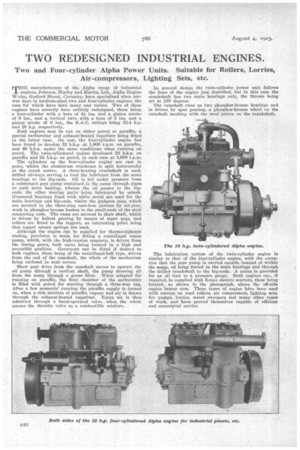TWO REDESIGNED INDUSTRIAL ENGINES.
Page 24

If you've noticed an error in this article please click here to report it so we can fix it.
Two and Four-cylinder Alpha Power Units. Suitable for Rollers, Lorries, Air-compressors, Lighting Sets, etc.
THE manufacturers of the Alpha range of industrial engines, Johnson, Hurley and Martin, Ltd., Alpha Engine Wrrks, Gosford Street, Coventry, have specialized since prewar days in medium-sized two and four-cylinder engines, the uses for which have been many and varied. Two of these engines have recently been entirely redesigned, these being a four-cylinder with a bore of 4/ ins, and a piston stroke of 6 ins., and a vertical twin with a bore of 5 ins, and piston stroke of 6 ins., the R.A.C. ratings being 32.4 h.p. and 20 h.p. respectively.
Both engines may be run on either petrol or paraffin, a special carburetter and exhaust-heated vaporizer being fitted in the latter case. On test, the four-cylinder engine has been found to develop 32 b.h.p. at 1,000 r.p.m. on paraffin, and 40 b.h.p. under the same conditions when running on petrol. The twin-cylindered engine developed 19 b.h.p. on paraffin and 24 b.h.p. on petrol, in each case at 1,000 r.p.m.
The cylinders on the four-cylinder engine are cast in pairs, whilst the aluminium crankcase is split horizontally at the crank centre. A three-bearing crankshaft is used, drilled oil-ways serving to lead the lubricant from the main bearings to the big-ends. Oil is fed under pressure from a submerged gear pump contained in the sump through pipes to each main bearing, whence the oil passes to the bigends, the other moving parts being lubricated by splash. Gunmetal bearings lined with white metal are used for the main bearings and big-ends, whilst the gudgeon pins, which are secured in the three-ring cast-iron pistons by set-pins, work in phosphor-bronze bushes in the small-ends of the steel connecting rods. The cams are secured to their shaft, which is driven by helical gearing by means of taper pegs, and rollers are fitted to the tappets, an interesting point being that tappet return springs are used.
Although the engine can be supplied for thermo-siphonie cooling, provision is made for fitting a centrifugal water pump, whthh, with the high-tension magneto, is driven from the timing gears, both units being located in a high and accessible position. Governors can be fitted if desired to both engines, these being of the centrifugal-ball type, driven from the end of the camshaft, the whole of the mechanism being enclosed in neat covers.
Skew gear drive from the camshaft serves to operate the oil pump through a vertical shaft, the pump drawing oil from the sump through a gauze filter. When adapted for running on paraffin, the float chamber of the carburetter is filled with petrol for starting through a three-way tap. After a few moments' running the paraffin supply is turned on, when a rich mixture of paraffin vapour and air is drawn through the exhaust-heated vaporizer. Extra air is then admitted through a hand-operated valve, when the whole passes the throttle valve as a combustible mixture.
In general design the twin-cylinder power unit follows the lines of the engine just described, but in this case the crankshaft has two main bearings only, the throws being set at 180 degrees.
The camshaft runs on two phosphor-bronze bearings and is driven by spur gearing, a phosphor-bronze wheel on the camshaft meshing with the steel pinion on the crankshaft.
The lubrication system of the twin-cylinder engine is similar to that of the four-cylinder engine, with the exception that the gear pump is carried outside instead of within the sump, oil being forced to the main bearings and through the drilled crankshaft to the big-ends. A union is provided for an oil lead to a pressure gauge. Both engines can, if required, be supplied with Rotax electric starters, these being located, as shown in the photograph, above the off-side engine bearer arm. These types of engine have been used with success on road rollers, air compressors, lighting sets, fire pumps, lorries, street sweepers and many other types of work, and have proved themselves capable of efficient and economical service.




























